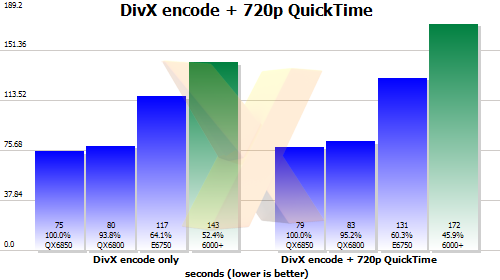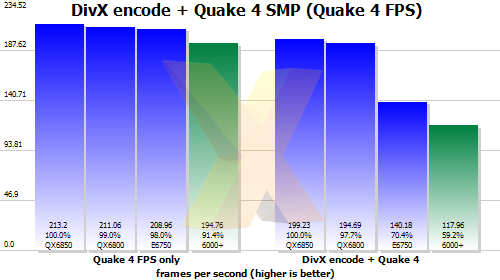Multi-tasking performance
Single benchmarks often make it difficult to see the benefit of multi-core processors, since they leave two or three cores sitting around idle.
However, the reality is that few people using PCs only carry out one task at a time - they have lots of apps on the go and that's when the true benefit of multi-core processors can be seen.
For our first test we run our DivX encoding benchmark while playing back a 720p QuickTime-encoded video.
We record the total times taken to compete the DivX encode and compare them with the original DivX-only results. Naturally, we also take a look at the QuickTime playback, to see if we can spot any dropped frames during playback.
After that, we run the DivX encoding test at the same time as our Quake 4 game test. This allows us to see how a heavy, multi-threaded, load affects the performance of the DivX encoding and the impact on the performance of Quake 4.

Watching a 720p QuickTime movie barely fazes the quad-core processors. The QX6850 sees DivX encoding taking just four seconds longer - and it's only three seconds for the QX6800.
However, the affect on the dual-cores is more dramatic. The E6750 takes an additional 14 seconds to complete the test. But that's still less time than the Athlon 64 X2 6000+ took for DivX encode running on its own. Add in QT playback and the 6000+ ends up taking a whooping 29 seconds longer to encode to DivX.
All the while, though, each processor - even the AMDs - coped admirably with QuickTime playback, with no dropped frames.

In the joint test with DivX encoding and the Quake 4 demo, the quad-core chips again see little in the way of performance loss compared to running Quake 4 alone - less than 20fps in each case.
As with the previous tests, though, the dual-cores take a dive, with a near-60fps drop for the E6750 and 77fps for the 6000+.
Additionally, while the quad-core processors allowed Quake 4 to run smoothly for the duration of the demo, the E6750 and 6000+ suffered bouts of slowdown and jerkiness.

Looking at the DivX encoding times with our Quake 4 demo running, we see that, once again, the performance decrease on the quad-cores is considerably less than that on the dual-core CPUs.
Summary
The Intel Core 2 Extreme QX6850 is the fastest CPU to have passed through the HEXUS labs thus far but, with a price tag of around £600, you'd expect nothing less. It wins every real-world benchmark that isn't limited by the GPU or by a less-than-perfect motherboard (in combination with testing variance).
As for the Core 2 Duo E6750, it consistently performs on a par with, or slightly faster than, the E6700, despite the issues we had with the motherboard.
Ideally we'd have run all our Intel processors on the MSI P35 Platinum board but Intel pulling in the NDA for this review by a week, so we simply didn't have time enough to use it for the QX6800 or the E6700.
Looking at these results, it's clear that, for AMD, its new K10 architecture and native quad-core derivatives simply can't come soon enough.The Athlon 64 X2 6000+ is unable to match the E6750 or E6700 in any of our benchmarks and some of the multi-tasking results are just plain embarrassing.
The Core 2 Duo E6750 can complete our multi-tasking DivX encoding and Quake 4 test in almost the same time it takes the 6000+ to carry out the DivX encoding on its own.









